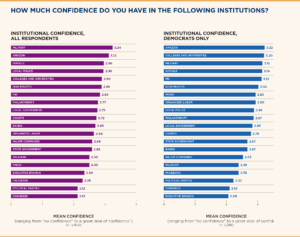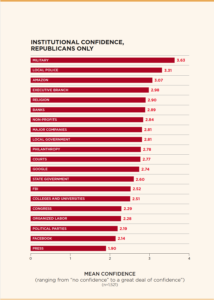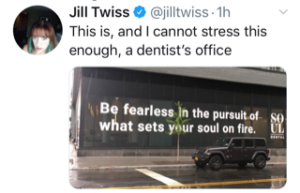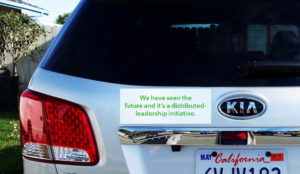Getting Your Story Right
I’ll begin with my favorite alarming research insight about perceptions of higher education. It’s the 2018 American Institutional Confidence Poll, which is sponsored by Georgetown University’s Baker Center for Leadership & Governance. The results were published in October last year.


College and universities ranked fifth overall in the public’s confidence—not bad, you think, until you look at where Amazon is ranked overall, and then at the difference in perception between Democrats and Republicans.
A writer from New York Magazine framed the poll results this way: “I like higher education and nonprofits quite a bit, but I’m not sure I always trust them to fulfill their mission. When I hit that one-click order button on Amazon, however, I deeply trust that the humidifier for my daughter’s nursery will arrive within two days.”
You probably have an alarming study of your own—say, the one in which the majority of those surveyed agreed with statements that funding for public higher education has remained the same or increased, when in reality funding has decreased by $7 billion over the past decade.
So what are we going to do about it? Lipman Hearne and AKA began working together almost a decade ago because we knew that institutions had to start telling better stories at the leadership level. Our first collaboration was The Power of SUNY, a system-wide strategic plan that put narrative at the forefront:
There is a growing and welcome recognition that in a knowledge economy, institutions of higher education can—and must—be pivotal in generating growth and revitalizing communities. Thus, SUNY will commit our energy and resources to revitalizing the economy of New York and enhancing the quality of life for its citizens.
I’ll concede it isn’t “Call me Ishmael.” But in the 2010 higher ed landscape, it was a grab-‘em-by-the-collar opening line. Accompanied by “Six Big Ideas” (like SUNY and the Entrepreneurial Century, SUNY and the Seamless Educational Pipeline—The New York Times called them “pragmatic and somewhat buzzy,” which made my week)— it got the attention of the governor and state legislators, shifting SUNY’s storyline in their eyes from that of an entity that came with both hands out in budget season to a partner eager to serve as a powerful engine of economic and community enhancement for New York State.
Storytelling is usually associated with branding and marketing, but we think the success of the strategic plans we’ve worked on together proves that a great core story isn’t something that can wait until you issue the RFP for branding and marketing. It has to be woven into the strategic planning process.
Here’s why: Humans learn from and with stories. The stories we tell ourselves drive our decision making. That’s why Lipman Hearne and AKA share a belief that every strategic plan needs to be built around a core story: an organizing and clarifying narrative that a campus community co-creates, expressing who it is, where it wants to go, how it will get there, and how it will persuade others to join in that journey. It should say something about the institution, of course—but it should also assert a compelling worldview and invite audiences to see their own values reflected in it.
A strong core story can’t inoculate an institution against all bad behaviors, external and internal. But it can help stakeholders see new connections between the institution and their own values and goals. It can reframe conversations. Most important, it can help ensure that a strategic plan doesn’t gather dust on the shelf.
That’s why, in the most successful strategic planning processes we’ve worked on, the president, provost, dean, or department head asks from the start, “How am I going to use this plan to create clear and powerful messages for our different stakeholders?” And conversely, the most successful branding and marketing campaigns we’ve developed begin with that same leader handing us a strategic plan that conveys the college or university’s vision boldly and succinctly.
In short, a core story is a powerful narrative about the institution, which the strategic plan bundles into a succinct vision statement, and which the college “unpacks” in the branding and marketing it uses to get its story out.
But that story has to have some muscle in it. A generic story about discovery, transformation, service, and passion isn’t enough anymore. Especially passion. As Xanthippe Voorhees, a character in Netflix’s Unbreakable Kimmy Schmidt, once said: “I’m majoring in finding my passion at Columbia, and, uh…it’s all about finding your passion.”
Developing a core story has also become more challenging because every consumer product—from law firms to gyms—wants to embrace a higher purpose these days. A couple of years ago, I saw an airport ad for the Bechtel Corporation—complex world, big challenges, we’ve got the solutions—that could have easily been a brand ad for a major research university.
I think where we are now was best summed up by another fictional character, Hooli CEO Gavin Belson, from the TV comedy Silicon Valley: “I don’t know about you people,” he told his employees at the Google-like start-up, “but I don’t want to live in a world where someone else makes the world a better place better than we do.”
And audiences are catching on:


As more and more businesses and organizations adopt the language traditionally used by higher education, it’s time that higher ed stories evolve beyond, “The world is a complex, challenging place, but darn it, we’ve got the answers, so stand back, we’ll take it from here.” This is especially true as both institutions and stakeholders wrestle with demographic changes; funding issues; disparities in education, health care, and opportunity; and what it will take to create strong, creatively vital communities.
We need to rethink higher ed core stories. The strongest stories in higher education are going to be about the willingness and ingenuity of colleges and universities to build social capital—shared goals, collaborative approaches, enduring partnerships— both within and beyond the walls of their institution.
In his great work on the rebirth of American communities, James Fallows points to the importance of research universities:
Research universities have become the modern counterparts to a natural harbor or a river confluence. In the short term, they lift the economy by bringing in a student population. Over the longer term, they transform a town through the researchers and professors they attract: When you find a Chinese or German physicist in the Dakotas, or a Yale literature Ph.D. in California’s Central Valley, that person probably works for a university. Research universities have become powerful start-up incubators.
His metaphor points to a powerful narrative that colleges and universities can draw on in their own distinctive ways.
The strongest core stories—and the strategic plans they bring to life—tell stories of how an institution can be an aggregator of great ideas from many different sources: in addition to scholars and makers on campus and around the world, sources like the local community college, the K-12 system, students from an incredible range of life experiences, community organizations of all kinds, local governments. The university, with its array of expertise, its core mission of teaching, research, and service, and its openness to the world at a local and global level, can be the spark, the ignition, the connective tissue for ideas and people.
And in doing all that, a university or college will offer a model for citizenship and involvement for individuals—sometimes as leaders; sometimes in supporting roles; always adaptable to the rapidly shifting situations they will confront. This is a way of being in the world that graduates can take with them wherever they go.
The future is going to be shaped by collaborative, distributed-leadership initiatives. There is no reason why academic brands can’t embrace that.

Okay, maybe not a great bumper sticker. But there are great stories here, all of which speak to higher education’s core missions of learning, research, and service: how relationships begin and grow, how people put aside their skepticism and animosity and come together for an idea or cause that’s bigger than any of them individually. All of these vividly challenge the shrinking public confidence in higher education that we noted at the start of this discussion. They are stories we want to, and can, believe in.
Libby Morse is Senior Vice President and Creative Director of Lipman Hearne. This article is based on remarks presented at the Mellon Sawyer Seminar, “Academic Brands: Privatizing, Qualifying, Reforming, and Transforming the University,” held at the University of California Davis, in March 2019.


